
Powelliphanta is a genus of large, air-breathing land snails, pulmonate gastropods in the family Rhytididae, found only in New Zealand. They are carnivorous, eating invertebrates, mostly native earthworms. Often restricted to very small areas of moist forest, they are prey to introduced mammalian predators, and many species are threatened or endangered.

Leiopelma is a genus of New Zealand primitive frogs, belonging to the suborder Archaeobatrachia. It is the only genus in the monotypic family Leiopelmatidae. The leiopelmatids' relatively basal form indicates they have an ancient lineage. While some taxonomists have suggested combining the North American frogs of the genus Ascaphus in the family Ascaphidae with the New Zealand frogs of the genus Leiopelma in the family Leiopelmatidae, the current consensus is that these two groups constitute two separate families. The four extant species of Leiopelmatidae are only found in New Zealand.
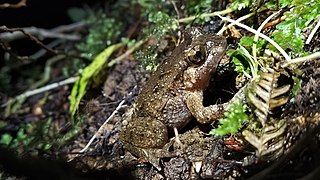
Hochstetter's frog or Hochstetter's New Zealand frog is a primitive frog native to New Zealand, one of only four extant species belonging to the taxonomic family Leiopelmatidae. They possess some of the most ancient features of any extant frogs in the world.

Coccinella leonina, common name orange-spotted ladybird, is a species of ladybird native to New Zealand. It is black with orange spots. A predator species, it is present in a variety of habitats.

Hadramphus, commonly known as knobbled weevils, is a genus of flightless molytine weevils from the family Curculionidae. It is endemic to New Zealand and consists of four species.
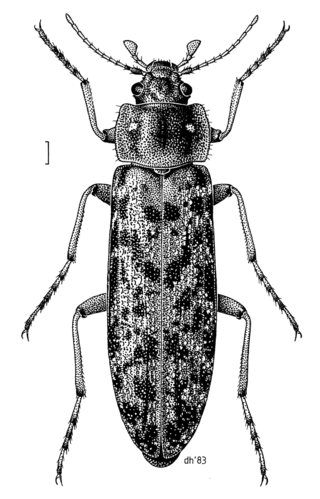
The Chalcodryidae are a family of beetles in the superfamily Tenebrionoidea. It contains at least five species in two genera Chalcodrya and Philpottia, which are endemic to New Zealand. They are generally found associated with moss or lichen covered branches, with the larvae having been found to be associated with dead twigs. It is thought that they are noctural, feeding on lichen and other plant material at night. The genera Sirrhas and Onysius, formerly placed in this family, have subsequently been transferred to Promecheilidae.

Paramorpha marginata is a species of moth in the family Carposinidae. It is endemic to New Zealand and has been observed in the northern parts of the North Island. It has been observed in the canopy of kanuka forest and has been collected and reared from leaf litter beneath Leucopogon fasciculatus. It is regarded as a rarely recorded species.
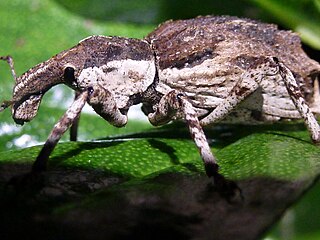
Anagotus stephenensis, commonly known as the ngaio weevil, is a large flightless weevil that is only found on Stephens Island in New Zealand. The ngaio weevil was discovered in 1916 by A.C. O'Connor on Stephens Island. Thomas Broun described it in 1921 as Phaeophanus oconnori after its collector. The weevils were observed at the time to be 'feeding on tall fescue and the leaves of trees'.
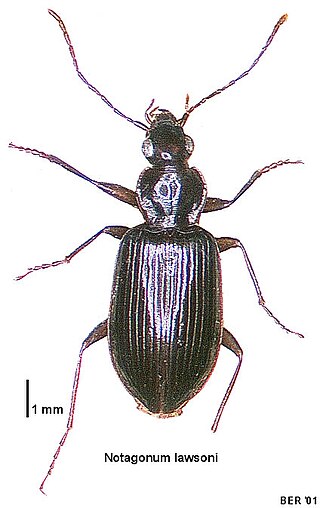
Notagonum lawsoni is a species of ground beetle in the subfamily Platyninae. It is endemic to New Zealand. It was described by Bates in 1874. Notagonum lawsoni has been collected from Metrosideros excelsa through the beating of foliage.
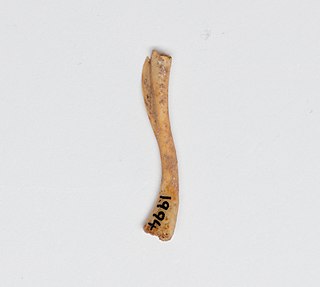
Markham's frog is one of three extinct New Zealand frog species, the others being the Aurora frog and Waitomo frog. Subfossil bones used to describe the species were discovered at Honeycomb Hill Cave, South Island, New Zealand, but it once occurred on both South and North Islands. It is estimated that it grew between 50 and 60 mm from snout to vent and it appears to have been a very robust animal.
The Waitomo frog is an extinct species of the genus Leiopelma from New Zealand.
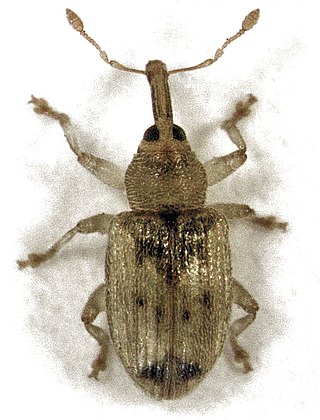
Peristoreus stramineus is a species of true weevil. It is endemic to New Zealand. The larvae develop in flower buds of Hoheria populnea.
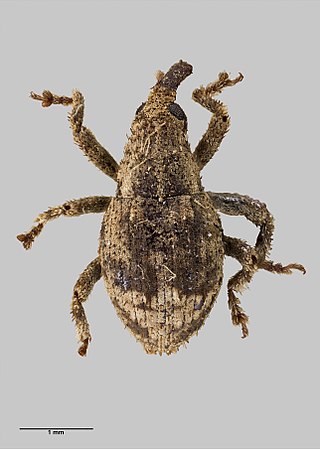
Didymus metrosideri is an endemic weevil from the Kermadec Islands in New Zealand. This species was discovered by W. L. Wallace during the 1908 Kermedec Islands expedition.

Lyperobius hudsoni is a flightless weevil found in alpine areas of Central Otago and Otago Lakes in the South Island of New Zealand.
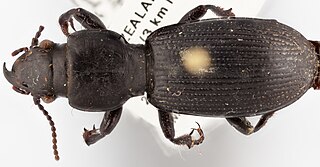
Mecodema atrox is a medium-sized ground beetle species that is closely related to Mecodema curvidens. Mecodema atrox is relatively rare in comparison due to its preferred habitat, the coastal broadleaf forests of the Coromandel Peninsula, a forest type that is in decline. The body of Mecodema atrox is black and the legs are dark reddish-brown. They can be distinguished from other Mecodema species by a number of characters, including the pattern of asetose punctures along the elytral striae.
Brenda Mabel May was a New Zealand speleological entomologist known for her contributions to the understanding of weevil larvae biology. Between 1956 and 1980, she worked in the Entomology Division of the Department of Scientific and Industrial Research (DSIR). Afterwards, she became a research associate at Landcare Research, where she completed a systematic overview of New Zealand Curculionoidea, published in 1993. In 1998, May was elected as a Fellow of the Entomological Society of New Zealand in recognition of her contributions.

David John Galloway, FRSNZ was a biochemist, botanist, and lichenologist.

Zapyrastra calliphana is a species of moth of the family Momphidae. It was first described by Edward Meyrick in 1889. It is found throughout New Zealand including at the Manawatāwhi / Three Kings Islands as well as at the Norfolk Islands. The preferred habitat of this species are native forest clearings, shrubland or coastal habitat such as scrub or dunes. The larvae of this species are leaf miners and are hosted by Muehlenbeckia species. There are likely several generations during the New Zealand summer and one generation overwinters as pupae. This species is a day flying moth and adults can be observed on the wing from October to March.
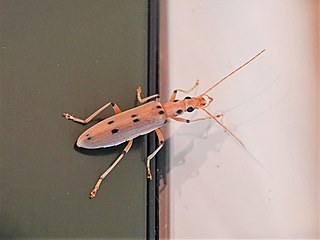
Parisopalpus is a genus of false blister beetles in the family Oedemeridae. The genus was first identified by Logan Hudson in 1975, who separated the group from Sessinia due to the presence of bifid mandibles, and n males of the species visible genitalia.

Parisopalpus nigronotatus, known by its common name, the spotted lax beetle, is a species of false blister beetles. It was first identified by Carl Henrik Boheman in 1858, under the name Nacerdes nigronotata. Native to eastern Australia, the species was introduced to New Zealand in 1931.


















